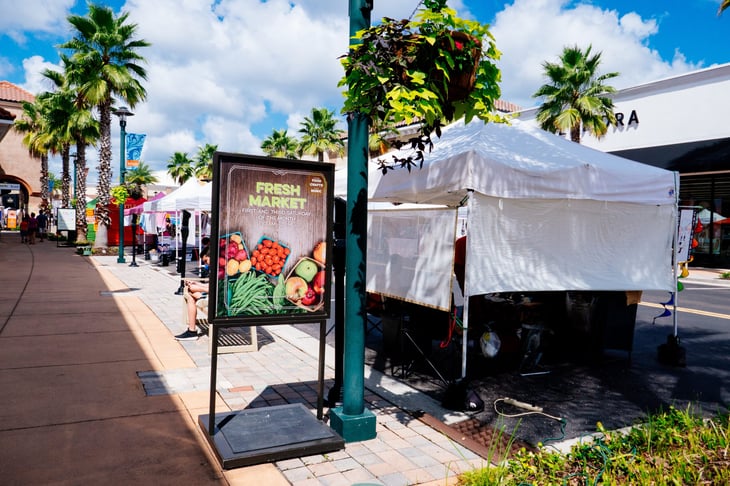
Editor's Note: This story originally appeared on SmartAsset.com.
While inflation continues to linger, food is among the few commodities whose prices haven’t skyrocketed in the last year. According to the Consumer Price Index for All Urban Consumers, which tracks the price of goods and services, food prices were just 3.7% higher in August than they were 12 months earlier. That may sound like a lot, but when compared with the 25% increase in the energy index, food prices have been far more stable.
To determine where people spend the most on food, SmartAsset examined data for 22 metro areas from the Bureau of Labor Statistics’ 2019-2020 Consumer Expenditure Survey. We considered the following two metrics: average food spending per household and average household income. For details on our data sources and how we put all the information together to create our final rankings, check out the Data and Methodology section below.
This is SmartAsset’s third study on the places where people spend the most on food. Check out the 2020 version here.
1. Atlanta, GA

Average food spending in the Atlanta metro area was $9,430, according to the 2019-2020 Consumer Expenditure Survey, which was ninth-highest among all 22 metro areas. That’s nearly $2,000 more than it was two years earlier. The average household income, meanwhile, has dropped precipitously in recent years, falling from $98,429 in 2017-2018 to $77,339 in 2019-2020. The Atlanta metro area has the highest percentage of household income (5.14%) spent on food away from home and the second-highest spent on food at home (7.05%).
2. Anchorage, AK

In the Anchorage, Alaska, metro area, food expenditures account for 11.24% of the average household income, the second-highest percentage of all 22 areas in our study. Anchorage, No. 11 in last year’s rankings, vaulted nine spots up this year. Residents spend an average of $10,291 on food each year, while 7.51% of the average household income pays for food eaten at home, the highest such percentage of any metro area.
3. Tampa, FL

Residents of greater Tampa, Florida, spend on average 10.85% of their household income on food each year, the third-most out of all 22 metro areas examined. Only Atlanta has a higher percentage of household income spent on food away from home. In Tampa, people spend 4.69% of their income, or $3,699, on food outside of their homes.
4. Honolulu, HI

Residents of the Honolulu, Hawaii, metro area spend $9,953, or 10.4%, of their household income on food. While Honolulu’s average household income in 2019-2020 was $95,678, the typical household spent $6,118 on food at home and $3,835 more on food away from home.
5. Chicago, IL

Average food expenditures in the Chicago, Illinois, metro area are 10.39% of the average household income, fifth-highest of all 22 metro areas in our study. Chicago residents spend an average of $5,642 each year on food at home. Home food expenditures are 6.7% of the average household income ($84,208), the third-highest among all 22 metro areas.
6. San Diego, CA

Only residents of the San Francisco, California, metro area spend more money on food each year than those who live in greater San Diego. On average, households in the San Diego metro area spend $11,067 on food every year, which is 10.05% of the average household income. Meanwhile, spending on food away from home accounts for 4.56% of the average household income in San Diego, the third-highest across our study.
7. New York, NY

Residents of the nation’s largest population center spend an average of $9,694 per year on food, which is 9.65% of the average household income there. New York is 11th out of 22 metro areas for average household income ($100,425). Of that money, people spend an average of $5,987 on food at home and $3,706 more on food away from home.
8. Boston, MA

With the sixth-highest average household income ($113,592), the Boston, Massachusetts, metropolitan area spends $10,860 on food per year, which is 9.56% of the average household income there. Boston ranks seventh for spending on food eaten at home, which is 6.11% of income ($6,938).
9. Los Angeles, CA

The second California metro area in the top 10, Los Angeles ranks ninth overall for food spending as a percentage of household income (9.49%). Residents of the City of Angels and its surrounding area spend an average of $8,869 per year on food, including $3,820 on food eaten away from home. That means L.A. residents spend 4.09% of the average household income on eating out, the fifth-highest percentage for that metric.
10. Miami, FL

While residents of the Miami, Florida, metro area spend less on food each year ($6,178) than every other metro area in our study, they also have the lowest average household income of those metros, $67,286. As a result, Miami’s average food costs are 9.18% of the average household income. Meanwhile, Miami residents tend to prioritize eating at home: They spend 6.48% of household income on food at home, fourth-highest for that metric, and just 2.7% on food away from home, second-lowest in the study for that metric.
Data and Methodology

To find the places where people spend the most on food, we looked at data for all 22 metro areas included in the Bureau of Labor Statistics’ 2019-2020 Consumer Expenditure Survey. Specifically, we examined data for the following metrics:
- Average food spending. This is the annual amount that the average household spends on food (including food at home and food away from home).
- Average household income. This is the annual average household income.
We divided the average food spending in each metro area by the average household income in that area. The result represents the average food spending as a percentage of total income. We ranked the places according to those percentages from highest to lowest. Though we did look at the differences in spending on food at home and on food away from home, we considered overall food spending for ranking purposes, not those individual designations.





Add a Comment
Our Policy: We welcome relevant and respectful comments in order to foster healthy and informative discussions. All other comments may be removed. Comments with links are automatically held for moderation.